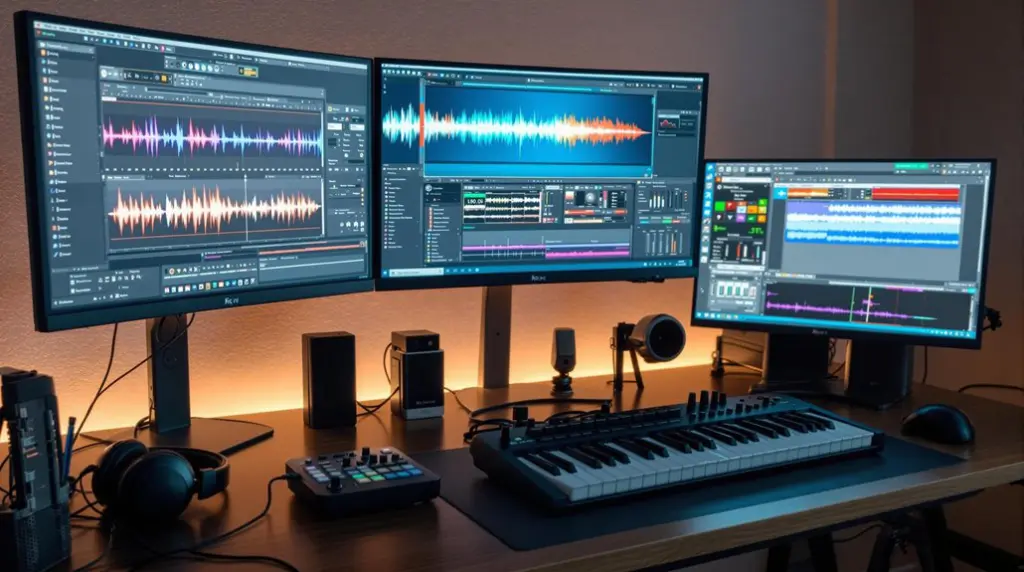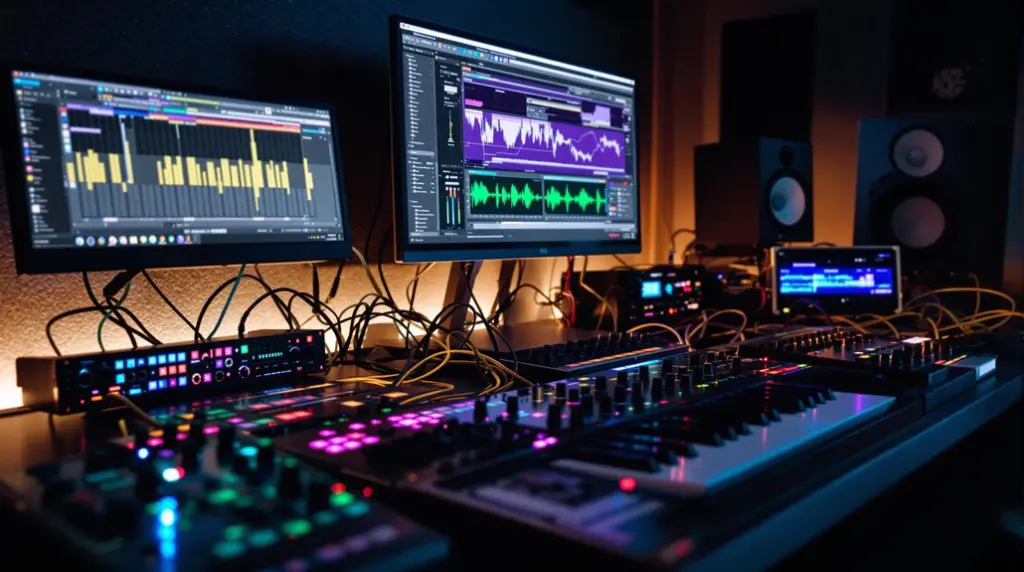Our review of the Korg Monologue spotlighted seven vital insights: its exceptional sound production through dual Voltage Controlled Oscillators (VCOs), compact yet robust design featuring a wooden rear panel and a 25-note keyboard, and user-friendly 16-step sequencer enabling complex parameter automation. The Monologue also boasts impressive analog drive circuitry for warm distortions and diverse connectivity options with MIDI, USB, and standard audio jacks, ensuring seamless integration. Its support for microtonal scales and real-time motion sequencing further extends creative possibilities. To fully understand the depth and versatility this synthesizer offers, more intriguing details await.
Key Takeaways
- Dual VCOs with three waveforms enable extensive sound shaping for a variety of tones.
- The 16-step sequencer supports real-time recording and parameter automation.
- Compact design with a 25-note velocity-sensitive keyboard enhances portability.
- Integrated USB and MIDI connectivity ensure seamless integration with other devices.
- Analog Drive circuit provides variable distortion effects for richer, warmer sound.
Overview and Pricing
The Korg Monologue, positioned within the $299 to $459 price range, presents a compelling option for both novice and seasoned synthesizer enthusiasts. Its affordability does not compromise on quality, making it a standout in a competitive market. As a monophonic analog synthesizer, the Monologue excels at generating rich bass and lead sounds, which is pivotal for users focused on distinct tonal qualities. Additionally, comprehensive tutorials available online can help users maximize the Monologue’s capabilities, enhancing its value.
From a user experience perspective, the Monologue’s compact design, featuring a 25-note velocity-sensitive keyboard, is particularly advantageous for live performances and portability. This design consideration enhances its usability, making it a practical choice for musicians on the go.
The Monologue also continues the legacy of the revered Korg MS-20 and Monotron series, incorporating enhanced capabilities that cater to modern synthesis needs.
In terms of market comparison, the Monologue’s price point and features position it favorably against other entry-level synthesizers. Its five color variations, including the striking gold metallic front, add an element of aesthetic customization, appealing to users who value both functionality and visual appeal.
Consequently, the Monologue’s blend of affordability, design, and legacy makes it a remarkable contender in the synthesizer market.
Sound and Performance
Korg Monologue’s sound and performance capabilities stand out markedly in the domain of monophonic synthesizers. At the heart of its impressive sound design are the two Voltage Controlled Oscillators (VCOs), which offer a wide range of waveforms such as sawtooth, square, and pulse. This flexibility enables the creation of rich and varied tones, making it essential for electronic, pop, and experimental music genres.
The Monologue’s performance dynamics are further enhanced by its fast and responsive envelope, which is meticulously tailored for monophonic sound production. This guarantees dynamic musical phrases, providing users with an expressive tool for live performances and studio sessions alike. The integrated 16-step sequencer plays a significant role in real-time parameter automation, allowing users to tweak sounds on the fly, thereby adding a layer of depth to the performance.
A unique feature of the Monologue is its Analog Drive circuit, which introduces variable distortion effects. This addition contributes to a warmer, more textured sound output, making the synthesizer versatile and sonically appealing.
| Feature | Description |
|---|---|
| VCOs | Two with sawtooth, square, and pulse waveforms |
| Envelope | Fast, responsive, tailored for monophonic sounds |
| Sequencer | 16-step with real-time parameter automation |
| Analog Drive Circuit | Variable distortion effects for textured sound |
| Ideal Genres | Electronic, pop, experimental |
Features and Limitations
Building on its robust sound and performance capabilities, the Monologue‘s rich feature set and certain limitations warrant a closer examination. At the core, the dual Voltage Controlled Oscillators (VCOs) with three waveform options each provide extensive sound shaping potential, allowing users to craft a wide array of tonal textures.
The inclusion of a 16-step sequencer with parameter automation facilitates intricate pattern creation, though the absence of a dedicated arpeggiator could be seen as a limitation for those seeking more complex sequencing options. Additionally, the Monologue benefits from integration with modern synthesizers, enhancing workflow and sound design intuitiveness.
A standout feature is the Monologue’s support for microtonal scales, enabling creative tuning across six octaves. This allows for the exploration of non-standard tunings, greatly expanding the instrument’s sonic palette.
The Motion Sequencer enhances dynamic sound changes by recording knob movements, yet the two-stage envelope generator may restrict more nuanced envelope shaping.
Connectivity is another strong suit, with MIDI In/Out and USB support ensuring seamless integration with DAWs and other external devices. Furthermore, battery operation enhances portability, catering to musicians who require flexibility for on-the-go performances.
Despite certain limitations, the Monologue provides an all-encompassing toolkit for both studio and live environments.
Design and Build Quality
From a user’s perspective, the Monologue’s design and build quality are both functional and refined, marrying aesthetic appeal with structural integrity. The wooden rear panel not only augments the aesthetic appeal but also enhances durability, giving the unit a premium feel. This high-quality woodworking is a demonstration of Korg’s commitment to producing visually and physically robust instruments.
The superior speakers in the Monologue guarantee ideal audio output, making it a reliable choice for professional settings.
The compact 25-note E-E keyboard layout is a masterstroke in balancing functionality with portability features. Musicians who frequently travel will appreciate its lightweight design without sacrificing playability. This compact format does not hinder performance, making it an ideal choice for both studio and live settings.
Additionally, the Monologue’s availability in five color variations—silver, black, dark blue, gold, and red—offers a personalized touch, catering to diverse stylistic preferences. Full-sized audio connections for main output, headphone, and input guarantee seamless compatibility with a wide range of audio setups, a vital feature for professional musicians.
MIDI I/O ports and USB connectivity are thoughtfully integrated, facilitating effortless integration with other musical gear and devices. These features collectively make the Korg Monologue a versatile and reliable instrument, marrying design ingenuity with practical user-centric considerations.
Sequencer Capabilities
A standout feature of the Monologue is its sophisticated 16-step sequencer, which notably amplifies creative potential for users. The sequencer supports real-time recording and parameter automation, pivotal for intricate sound design and dynamic performances. Users can explore three sequencing modes: Note, Slide, and Motion, allowing for a versatile range of sequencer patterns. These modes enable capturing knob movements, translating into fluid and evolving soundscapes.
One of the key advantages is the adjustable pattern lengths, spanning from 1 to 16 steps, which offer flexibility in crafting unique rhythmic sequences. Parameter locks further enhance this by allowing precise data capture for individual steps, facilitating detailed manipulation of notes and modulation settings.
| Mode | Function | Benefit |
|---|---|---|
| Note | Records and sequences notes | Essential for creating melodic lines |
| Slide | Captures portamento movements | Adds fluid shifts between notes |
| Motion | Automates knob movements | Introduces dynamic sound changes |
Visual feedback through lit buttons is another notable feature, considerably improving navigation and clarity during live performances. This facilitates a user-friendly interface, ensuring seamless sequencing sessions. Overall, the Monologue’s sequencer capabilities are integral for users seeking advanced sound crafting and performance versatility.
Connectivity and Integration
The Korg Monologue boasts extensive connectivity options, featuring standard 1/4 inch jacks for audio, sync, and MIDI connections, which guarantee its seamless integration with a variety of external equipment.
This versatility is akin to the PreSonus Studio 68c with its 6-in/6-out USB-C connectivity.
USB support for MIDI integration with computers enables effortless synchronization with digital audio workstations, enhancing digital workflow efficiency.
Additionally, the audio input capability allows for the processing of external signals, thereby broadening the Monologue’s functional scope beyond its internal sound synthesis capabilities.
MIDI and USB Integration
MIDI and USB integration on the Korg Monologue offers musicians a robust and versatile connectivity framework essential for modern music production. The inclusion of MIDI In/Out ports provides notable MIDI advantages, enabling seamless integration with external MIDI devices. This feature is particularly beneficial for users who wish to expand their setup by connecting the Monologue to other synthesizers, drum machines, or MIDI controllers, thereby enhancing their creative possibilities.
The USB connectivity offers considerable USB benefits, facilitating MIDI integration with Digital Audio Workstations (DAWs). This allows for a streamlined workflow, as users can easily connect the Monologue to their computers and software, guaranteeing efficient control and synchronization of their musical projects.
The standard 1/4 inch jacks for MIDI, sync, and audio connections further improve its compatibility with a wide range of equipment, making it an excellent choice for both studio and live performance settings.
Additionally, the compact design of the Monologue, combined with its versatile connectivity options, assures that it fits seamlessly into various setups. This flexibility is particularly advantageous for live performers who require reliable and straightforward integration into their existing rigs.
Audio and Sync Options
How does the Korg Monologue excel in its audio and sync options? The Monologue is designed with versatility in mind, featuring standard 1/4 inch jacks for audio output and MIDI In/Out. This facilitates seamless audio routing and integration within a broader array of studio equipment or live performance setups.
The inclusion of a USB port for MIDI connectivity further enhances its utility, providing a direct link to computers and digital audio workstations (DAWs) for an expanded workflow.
One of the standout features is the audio input, which allows users to process external signals through the Monologue’s robust signal processing capabilities. This greatly broadens the synthesizer’s functionality, enabling it to act as an effect unit for other instruments or audio sources.
Additionally, the headphone output is a thoughtful inclusion, offering the convenience of silent practice and making the Monologue suitable for various environments.
Compatibility with Korg’s extensive ecosystem of software and hardware products guarantees that the Monologue can be easily integrated into existing setups, enhancing its flexibility.
Whether in a professional studio or a home setup, the Monologue’s thorough connectivity options and signal processing features make it a versatile tool for musicians and producers alike.
Recommendations and Impression
When evaluating the Korg Monologue, one immediately appreciates its affordability and impressive feature set, particularly for a synthesizer priced around $299. The user experience is significantly intuitive, making it accessible for novices, yet its robust sound engine and modulation capabilities also cater to seasoned musicians.
The Monologue’s dual VCOs and unique filter design provide a rich palette of sounds, excelling in producing deep bass and lead tones suitable for electronic and experimental music. Additionally, the Monologue’s capabilities can be further expanded with versatile plugins that enhance sound quality, offering even more creative potential.
The creative potential of the Monologue is further amplified by its 16-step sequencer and built-in motion sequencing. These features allow users to capture and automate knob movements, introducing dynamic changes to sounds during performances. This is particularly beneficial for live settings where real-time manipulation is essential.
Despite some limitations, such as a simplified envelope generator and the absence of portamento controls, the Monologue remains a formidable synthesizer. Here are three key points that highlight its value:
- Affordability: Ideal for both beginners and professionals seeking high functionality under $500.
- User-Friendly Interface: Simplifies real-time parameter manipulation.
- Creative Tools: Motion sequencing and dual VCOs enhance sound design capabilities.
Frequently Asked Questions
What Is a Korg Monologue Good For?
The Korg Monologue is ideal for sound design and live performance in electronic, pop, and experimental music. Its 16-step sequencer, dual VCOs, and microtonal scales facilitate intricate sound shaping and dynamic real-time recording.
How Much Power Does the Korg Monologue Use?
The Korg Monologue demonstrates notable power efficiency with low consumption, enabling extended use via six AA batteries or a 9V DC adapter. This efficiency, combined with its robust sound design capabilities, makes it ideal for versatile applications.
Does the Korg Monologue Have a Sequencer?
The Korg Monologue indeed has a sequencer. Its sequencer features include a 16-step sequencer with Note, Slide, and Motion modes. These sequencer capabilities enable real-time recording, parameter automation, and storage of up to 100 patterns, benefiting both studio and live settings.
How Many Presets Are There in Korg Monologue?
The Korg Monologue offers a robust sound design platform with 80 factory presets and allows users to store up to 100 custom sound programs. Its analog synthesis capabilities provide a rich palette for both beginner and advanced synthesists.
Conclusion
The Korg Monologue emerges as a robust and versatile monophonic synthesizer, offering exceptional sound quality and advanced performance capabilities. Its extensive feature set, coupled with a durable design and effective sequencer, positions it as an excellent choice for both novice and experienced musicians. Despite some limitations in connectivity and integration, the overall value and innovation delivered by the Monologue affirm its status as a significant tool in modern music production.




